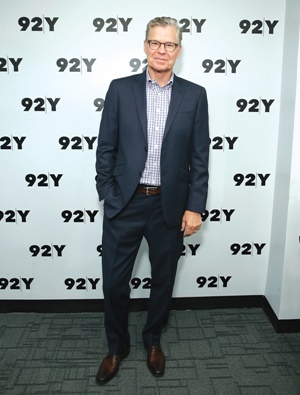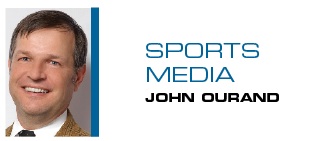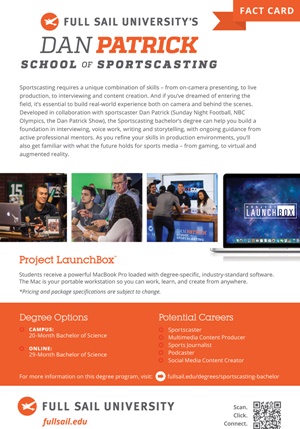D
an Patrick knew that he wanted to get into sports broadcasting when he graduated from the University of Dayton in 1979 — back in a time before the internet, cell phones and HDTV.
A broadcast journalism major, Patrick dabbled in media — he spun records for a rock ‘n’ roll radio station in Dayton after graduation. But he had no clue how to turn his interest into a sportscasting career. He wound up renting video and audio equipment, producing a five-minute sportscast.
“I sent it to Bob Ley at ESPN, who I’d eventually co-anchor with,” Patrick said. “Bob looked at the tape and said, ‘You have promise. But you need work.’”
Patrick ended up using the tape to land a sportscasting job at CNN in 1983, where he stayed for around six years before landing at ESPN in 1989.
“I was lost. I had no clue what I was doing, other than being on the radio,” Patrick said.
Despite all the advances in media technology from those early days, the process of finding an on-air job in media is still just as difficult. Patrick decided he wanted to do something to make it easier.
 |
The veteran broadcaster is lending his name and support to a program to train students for careers in front of, and behind, the camera.
GETTY IMAGES |
This week, he plans to unveil the plans behind the Dan Patrick School of Sportscasting at Full Sail University. The revenue-sharing partnership will see the Winter Park, Fla.-based for-profit university develop a sportscasting degree with instruction from Patrick and many of his industry colleagues.
The program launches Jan. 29. Administrators are in the process of hiring a regular faculty to teach the courses.
It already has commitments from what it calls a guest faculty. For example, a couple of times a year Bill Simmons, for example, could provide writing instruction, Jeremy Schaap could give talks on reporting and interviewing, and Jay Harris could teach the ins and outs of appearing on camera. They also are talking with former ESPN President George Bodenheimer about taking part.
“If the University of Phoenix and the Connecticut School of Broadcasting had a love child, it would look like this,” said Patrick’s agent, Reed Bergman, who brokered the deal.
Patrick hired Gus Ramsey, who he knew from his ESPN days, as program director. After a 23-year run in Bristol, Ramsey was part of ESPN’s 2015 layoffs and has been working as a talent coach for the past two years.
“There’s no better person who can be on the ground every single day teaching these kids what they need to do to get ready for local or national, ESPN, in front of the camera, behind the camera — he was that essential to this program,” Patrick said. “Firsthand knowledge is essential to this program. Gus was vital for that. In his job at ESPN, he would deal with the kids who had just graduated from college. They’d go in there and log highlights. Gus’ job was to work with them.”
Bergman and Patrick talked to Ramsey last year, believing that his background coaching on-air talent would fit naturally with what they were trying to accomplish.
“This was taking what I was doing and putting it on the best steroids in the world,” Ramsey said.
Ramsey said he had grown frustrated with how inexperienced recent college graduates were, from not knowing how to operate a teleprompter to not knowing the types of questions to ask during an on-camera interview.
“There was just a lack of understanding some of the basic day-to-day operational stuff,” Ramsey said. “I found myself constantly correcting things that people were learning in school. My mantra has become that in our classrooms, we’re going to teach you what people who have been in the control room have been learning for the past 20 years.”
Patrick had a similar experience. He said he first started thinking of developing a program like this 10 to 15 years ago after he kept running into recent college graduates who were as clueless about how to move forward in sportscasting as Patrick once was.
“I kept hearing questions that should have already been answered in college,” Patrick said. “How many reps did they get in front of a camera? Did somebody teach them how to do a podcast? Do they know how to speak in front of people? Have you had an interviewing coach? …
“I have a communications degree from Dayton. There wasn’t much to the curriculum that helped me get to where I am. In fact, the only class that really helped me was a speech class. The other things didn’t as much.”
Patrick and Bergman reached out to Full Sail University, a college that offers 80 programs in entertainment, media production and emerging technology.
“When Playbook reached out to us, that had been one of the degrees we’d been pondering,” said Full Sail President Garry Jones. “When Dan approached us, that really piqued our interest. To have a man of his stature and his reputation giving back — that’s our wheelhouse.”
Talks started in December 2015 with Josh Mora, Full Sail’s executive director of strategic planning. Mora started at Full Sail in 2010 after a five-year run as an on-air reporter for CSN Chicago. Back in 2010, Mora looked into launching a sportscasting degree but decided that it wouldn’t work.
“When Dan and Reed Bergman approached us about what Dan’s interests were, we decided to take another look about whether it made sense,” he said. “We decided these are the right people, this is the right time and this is the right program to launch an on-air degree.”
Patrick said that his goals for the program have less to do with numbers and more to do with reputation. Success is if local stations and networks call Full Sail looking for candidates.
“The best compliment I could get is if networks and local channels are asking if we have someone to fill their jobs,” Patrick said. ”It’s about placement. … Everybody wants to be on the air. Everybody. We want to give them the guidance so that they understand what it is, what the marketplace is like and how it’s changing.”
The program will be a mix of online and on-campus coursework.
Patrick stressed that he is doing more than licensing his name to Full Sail University. He is leading classes on campus at least four times a year, will be hosting webinars and using his contacts to talk to the students and, hopefully, place them at the end of their degree.
“I’m in,” he said. “It’s my name. I’m as prideful of this as I am the radio show that bears my name.”
John Ourand can be reached at jourand@sportsbusinessjournal.com. Follow him on Twitter @Ourand_SBJ.






